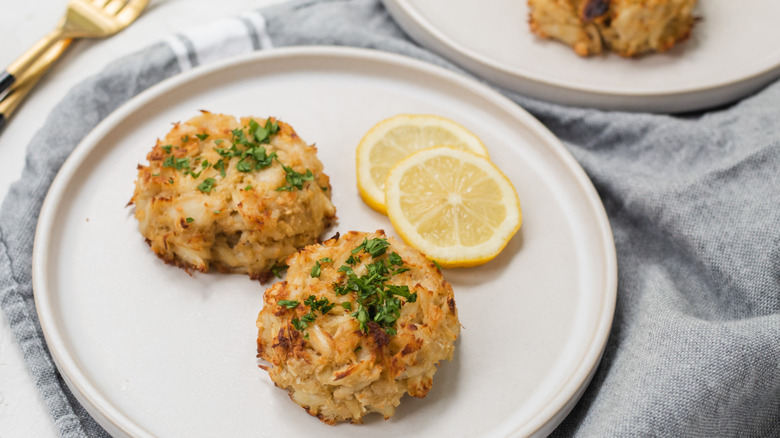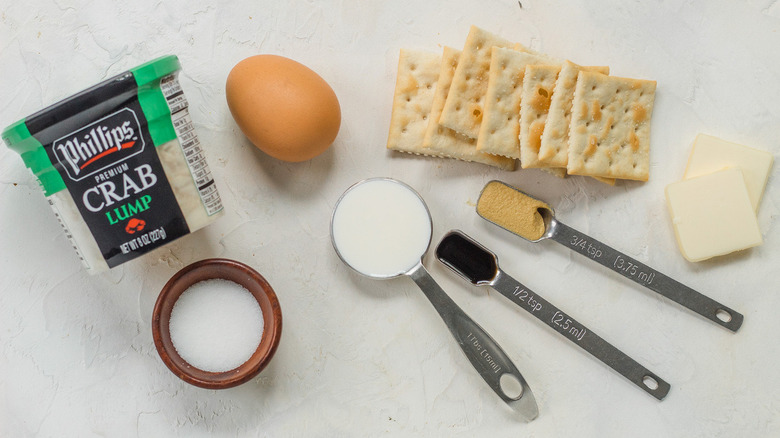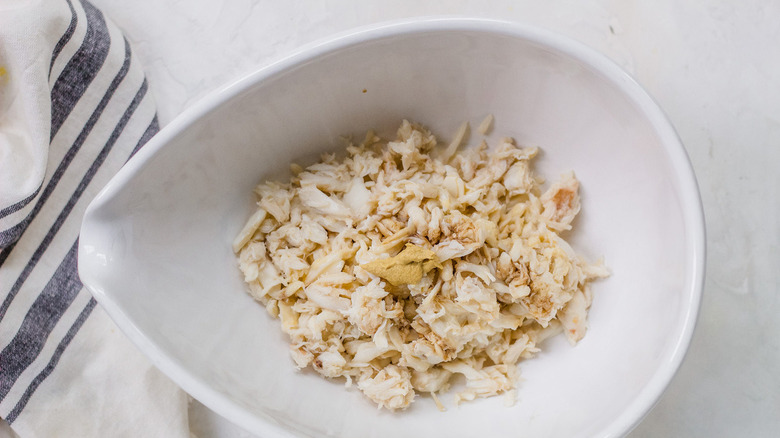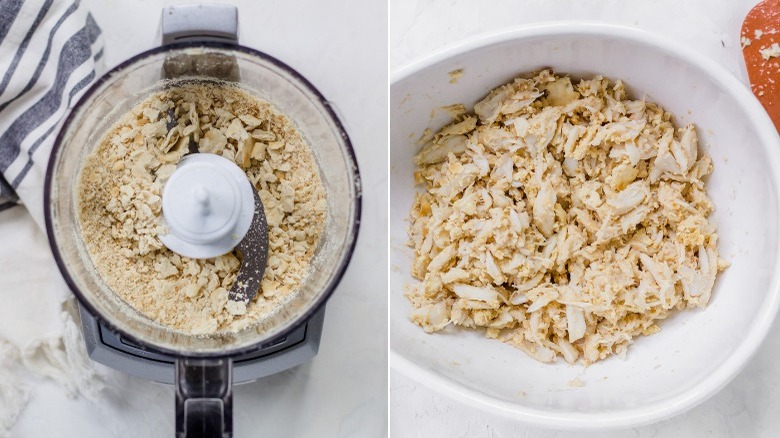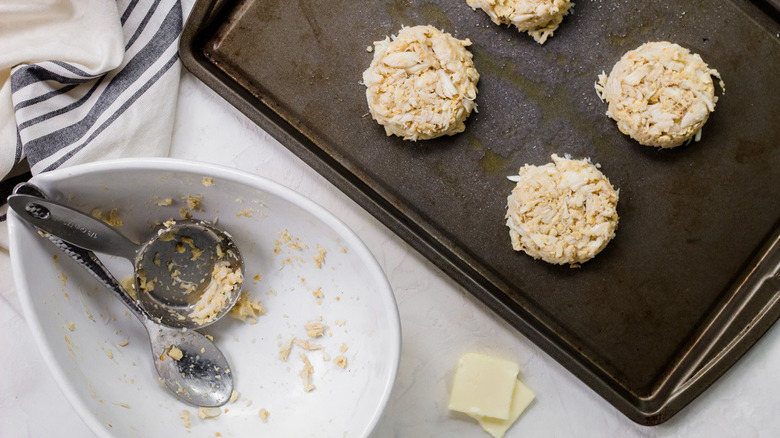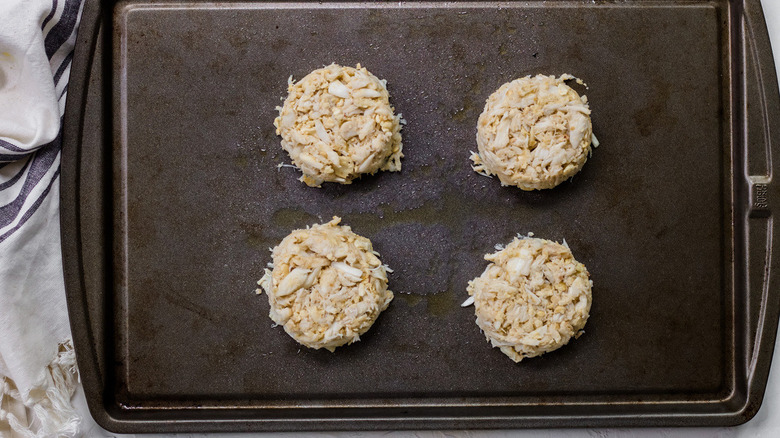Broiled Crab Cakes Recipe
It's always disappointing when you order crab cakes at a restaurant only to dig in and find yourself wondering, "Where's the crabmeat?" Well, recipe developer and dietician Jaime Bachtell-Shelbert who blogs at Wholly Nourished has created this recipe for crab cakes that is just bursting with crabmeat — so much so, in fact, that it's frankly kind of amazing how compact and well-structured they are. And that is because Bachtell-Shelbert has developed a crab cakes recipe that emphasizes the crabmeat by binding it together using nothing more than the equivalent of two saltine crackers (and a smidgeon of egg) rather than mounds of breadcrumbs.
It's a trick that Bachtell-Shelbert conceived of thanks to spending her childhood witnessing her mom making crab cakes at home in her crab-centric home state of Maryland "with a few minimal ingredients so that the crab really shined as the star ingredient," Bachtell-Shelbert notes. In addition, Bachtell-Shelbert wanted to develop a crab cake recipe that requires no frying. Instead, her recipe relies on the Maillard reaction that can be obtained in mere minutes using a broiler set to high. Let's take a deeper look at Bachtell-Shelbert's stunningly simple recipe for broiled crab cakes.
Gather the ingredients for broiled crab cakes
To make Bachtell-Shelbert's recipe for broiled crab cakes, you will need ½ pound of lump crabmeat, 1 tablespoon of half and half or heavy cream, 1 teaspoon of Worcestershire sauce, 1 teaspoon of Dijon mustard, eight saltine or similar crackers, 4 teaspoons of butter, and a pinch of salt. In addition, you will need ½ an egg, which Bachtell-Shelbert suggests measuring as follows: Crack an egg, beat it to combine the white and the yolk, and then measure out 2 tablespoons — that will be your equivalent of a half an egg. You'll also need olive oil or nonstick spray.
Optional: To plate your broiled crab cakes as beautifully as Bachtell-Shelbert, slice up some lemons, and chop up some fresh flat-leaf parsley. Then, you're well on your way to enjoying a five-star meal.
Get the oven ready, and start preparing the crabmeat mixture
To get things started, open your oven's door, and make sure that one of the oven racks is about five inches from the broiler's heat source. If not, move a rack so that it is. Then set the broiler to high, and close the oven door. While you're waiting for the broiler to heat up, spritz a baking sheet with olive oil or nonstick spray. Drain the crabmeat, and dab gently with a paper towel. Place the crab, egg, half and half, Worcestershire sauce, and mustard in a mixing bowl. Fold gently with a spatula, careful not to break up the crabmeat.
Crush and stir in the saltines
As noted above, Bachtell-Shelbert's broiled crab cakes are mostly made of crabmeat, along with a bit of seasoning. So that the cakes will hold together, they will also need something to give them structure. That's where the crackers come in. Bachtell-Shelbert advises crushing your crackers to a coarse crumb, which can be accomplished using a food processor or by placing the crackers in a zip-top bag and using a rolling pin to crush them. Once crushed, add the crackers to the crab mixture along with a pinch of salt, and fold to combine.
The simple way to form perfect crab cakes
All that is left to do at this point in terms of prep is to form the crab cakes. Bachtell-Shelbert suggests you do this by using a ⅓-cup measuring cup. Pack that cup with the crab mixture, and then turn the mixture out onto your prepared baking sheet. Repeat three times to make four crab cakes. Top each crab cake with a 1-teaspoon pat of butter. See how easy that was?
Broil the crab cakes, and enjoy
Place the baking sheet in the oven on that high-up rack, and set a timer for three minutes. Close the oven door, and allow the crab cakes to broil until the timer goes off. Then, move the baking sheet to the lowest rack, and close the oven door, setting the timer for another three minutes.
This time, when the timer goes off, leave the crab cakes in the oven with the oven door closed, and turn off the broiler. Set a timer for one minute, during which the crab cakes will continue to cook through, using retained heat. Remove the baking sheet after one minute, use a spatula to slide the crab cakes onto a plate or plates, and serve with or without the optional garnish and with or without Old Bay seasoning for layering on that traditional Maryland crab flavor.
Broiled Crab Cakes Recipe
This recipe for broiled crab cakes truly emphasizes the crabmeat by bringing it together with saltine crackers rather than mounds of breadcrumbs.
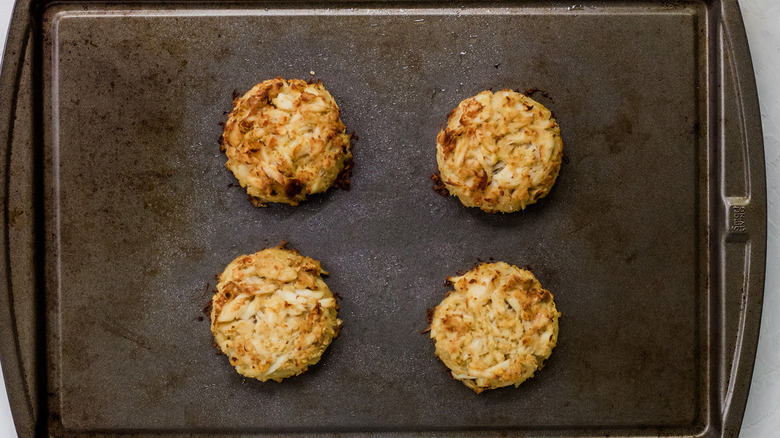
Ingredients
- ½ pound lump crabmeat
- ½ an egg (2 tablespoons of an egg, beaten)
- 1 tablespoon half and half or heavy cream
- 1 teaspoon Worcestershire sauce
- 1 teaspoon Dijon mustard
- 8 saltine crackers
- pinch of salt
- 4 teaspoons butter
Optional Ingredients
- lemon slices, for garnish
- chopped fresh parsley, for garnish
Directions
- Place an oven rack 5 inches beneath the broiler. Set the broiler to high.
- Prepare a baking sheet by lightly misting with olive oil or other nonstick spray.
- Drain the crabmeat, and dab it gently with a paper towel.
- Place the crab, egg, half and half, Worcestershire sauce, and Dijon mustard in a mixing bowl, and fold gently with a spatula, being careful not to break up the crabmeat.
- Crush the crackers to a coarse crumb.
- Add the cracker crumbs to the crabmeat mixture, and add a pinch of salt.
- Fold until well combined.
- Form four crab cakes, and place each on baking sheet.
- Top each crab cake with 1 teaspoon of butter.
- Broil the crab cakes for 3 minutes on the highest rack.
- Move the crab cakes to the lowest rack to prevent burning, and finish broiling another 3 minutes.
- Turn off the broiler, and let the crab cakes sit in the oven 1 more minute.
- Remove the crab cakes from the oven, and serve topped with optional lemon slices and fresh parsley.
Nutrition
| Calories per Serving | 120 |
| Total Fat | 5.8 g |
| Saturated Fat | 3.1 g |
| Trans Fat | 0.2 g |
| Cholesterol | 86.5 mg |
| Total Carbohydrates | 5.0 g |
| Dietary Fiber | 0.2 g |
| Total Sugars | 0.4 g |
| Sodium | 413.2 mg |
| Protein | 11.6 g |
